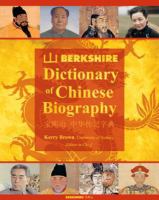Welcome to a new edition of our semi-regular feature in our blog: Reference Book of the Week. Here at Hutchins Library we have an excellent reference collection. It is a great resource for students, faculty, and staff. We use this series of posts to highlight specific items in our reference collection, telling our readers what the item does and how it can be used for your research needs.
 This week we are featuring a new item of interest to students and scholars in Asian Studies as well as world history, politics, and biography: The Berkshire Dictionary of Chinese Biography (the link goes to the book’s record in BANC, our library catalog). This three-volume set is designed for general readers seeking a working knowledge of Chinese history through its key figures.
This week we are featuring a new item of interest to students and scholars in Asian Studies as well as world history, politics, and biography: The Berkshire Dictionary of Chinese Biography (the link goes to the book’s record in BANC, our library catalog). This three-volume set is designed for general readers seeking a working knowledge of Chinese history through its key figures.
The set features three volumes. Entries in the dictionary cover emperors, politicians, poets, writers, artists, scientists, explorers, philosophers, and others. The dictionary features 135 long biographies that range from 1,000 to 8,000 words in length. Entries are written by scholars fro China as well as from Europe, America, and Australia. The three volumes cover from the beginnings of Chinese history to 1979, the year when China resumed diplomatic relations with the United States. A forthcoming fourth volume will bring coverage to the present day. The publisher states that this work is inspired by the Dictionary of National Biography to provide access to information similar to that set about Chinese persons. The publisher speaks further on the set’s coverage:
“. . . we have tried to strike a balance between the obvious figures who cannot be left out of any overview of Chinese history, and lesser known individuals, whose life and achievements can nonetheless provide insight into China’s development” (xxviii).
Each entry features the following components:
- The person’s name. (Right now, the volumes do not feature any living persons. In the forthcoming fourth volume, some living individuals will be featured. This is another way in which this set is different than the Dictionary of National Biography).
- The time and dates the person lived and a brief statement of what they did.
- Alternate name(s), if the person had any.
- A summary paragraph.
- The full entry essay.
- The set overall contains various illustrations. When available, there is at least a portrait of the person. Images come from various sources.
- A list of items for further reading.
How can you make use of this resource?
- The volumes are organized chronologically by dynasty or historical period. Within each period, articles are mostly alphabetical (there are some exceptions).
- Each volume has a complete list of entries for the specific volume and the set.
- The first volume contains an introduction, the publisher’s note, and a reader’s guide that gives further guidance on how to best use this set for research and learning.
- The third volume has a names index to help you find all the figures mentioned in the volume. If a person has a full entry in the dictionary, his or her name would be listed in bold letters.
- The set features helpful indices, a timeline, and a glossary.
As of this post, the set is being featured in the library display honoring the 15th Anniversary of Asian Studies at Berea College. It is a reference book, so it may not be checked out, but you can use it inside the library. After the display, the set will return to the second floor Reference Collection. You can find it under the call number REF 951.003 B5125 2014.


